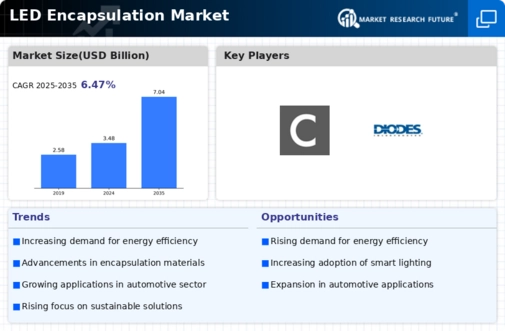Market Growth Projections
The Global LED Encapsulation Market Industry is projected to experience substantial growth over the next decade. The market is expected to expand from 3.48 USD Billion in 2024 to 7.04 USD Billion by 2035, reflecting a robust compound annual growth rate of 6.61% from 2025 to 2035. This growth trajectory indicates a strong demand for LED encapsulation across various sectors, including residential, commercial, and industrial applications. The increasing focus on energy efficiency and sustainability is likely to further fuel this expansion, positioning LED encapsulation as a critical component in the future of lighting solutions.
Expansion in Emerging Markets
Emerging markets are playing a pivotal role in the growth of the Global LED Encapsulation Market Industry. Countries in Asia-Pacific, Latin America, and Africa are witnessing rapid urbanization and infrastructure development, leading to increased demand for efficient lighting solutions. As these regions invest in modernizing their electrical systems, LED encapsulation is becoming a preferred choice due to its cost-effectiveness and energy efficiency. The anticipated market growth from 3.48 USD Billion in 2024 to 7.04 USD Billion by 2035 highlights the potential of these emerging markets in driving global demand.
Rising Environmental Concerns
Environmental awareness is a crucial driver for the Global LED Encapsulation Market Industry. As consumers become more conscious of their ecological footprint, there is a marked shift towards sustainable products. LED lighting, which offers lower carbon emissions and reduced waste compared to traditional lighting solutions, is increasingly favored. Governments are implementing stricter environmental regulations, encouraging industries to adopt greener technologies. This shift not only supports the growth of LED encapsulation but also aligns with global sustainability goals. The market's expansion is indicative of a broader commitment to environmental stewardship.
Growing Demand for Energy Efficiency
The Global LED Encapsulation Market Industry is experiencing a surge in demand for energy-efficient lighting solutions. As energy costs continue to rise, consumers and businesses alike are seeking alternatives that reduce electricity consumption. LED technology, known for its low energy usage and longevity, aligns perfectly with this trend. In 2024, the market is projected to reach 3.48 USD Billion, reflecting a growing preference for sustainable lighting options. Governments worldwide are also promoting energy-efficient technologies through incentives and regulations, further driving the adoption of LED encapsulation in various applications.
Increasing Adoption in Automotive Lighting
The automotive sector is increasingly adopting LED technology, significantly impacting the Global LED Encapsulation Market Industry. With the rise of electric vehicles and the need for energy-efficient lighting solutions, manufacturers are integrating LED encapsulation into headlights, taillights, and interior lighting. This shift not only enhances vehicle aesthetics but also improves safety and visibility. As automotive regulations become stricter regarding energy consumption and emissions, the demand for LED encapsulation is expected to grow. This trend aligns with the overall market growth, which is projected to reach 7.04 USD Billion by 2035.
Technological Advancements in LED Technology
Technological innovations in LED encapsulation are propelling the Global LED Encapsulation Market Industry forward. Advances in materials and manufacturing processes have led to improved performance, durability, and cost-effectiveness of LED products. For instance, the development of new encapsulation materials enhances thermal management and light output, which is crucial for high-performance applications. As these technologies evolve, they are likely to attract more investments and expand market opportunities. The anticipated growth from 3.48 USD Billion in 2024 to 7.04 USD Billion by 2035, with a CAGR of 6.61% from 2025 to 2035, underscores the potential of these advancements.













Leave a Comment